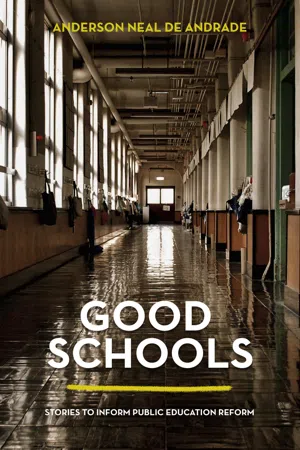![]()
Part II:
Good Ideas for Good Schools
In this next section of the book, we will begin to hear stories coming from the classroom that will lead us into conversation around certain areas of public education reform. The following reform topics will be discussed in this section:
1. Standardized testing and the collection of student data
2. Developing effective early childhood education programs
3. Aiding students in their transition out of high school
4. Building new school buildings and reimagining classrooms
5. Providing more mental health resources to students
6. Expanding access to educational technology in and out of schools
7. Creating culturally relevant curriculum and using project-based learning
8. Diversifying staff and desegregating schools
It is my hope that this section will further expand the understanding of what I heard in the stories and voices of the various individuals that were interviewed. All students’ names have been changed in order to ensure anonymity. The names of teachers have been kept upon their approval; for teachers who wished to remain anonymous, names were changed. Additionally, when stories use the first-person point of view, these are stories from my classroom and my experiences.
![]()
Chapter 5:
Rethinking Data
It was an unseasonably warm day for a Tuesday in April in Redwood City, California—windows open, industrial fan blowing, and all the lights out. The door to the classroom had to remain shut, cutting off any draft to ease the heat. In the room, thirty-eight fifth graders sat in rows, their faces glowing from the computer screens. Wearing identical school uniforms—light blue polo shirts and navy-blue pants—some wore sweatshirts despite the heat.
The walls were covered with large pieces of butcher paper, the kind that comes off in large rolls—a staple of elementary schools. The color the class had decided on was green. Hidden by the green paper was all the student work that had been completed and displayed for this school year: essays about families, posters of different ecosystems, charts that tracked science experiments, and self-portrait paintings.
Silence hung in the room as each student continued working.
As the clock moved, a new number of minutes remaining on the test was written on the board for each student to clearly see. They continued to stare at their screens.
On the floor of the classroom were two large carpets where the class had sat that morning. These carpets can be found in most elementary classrooms across the country. On these carpets, names are learned, lessons are taught, and games are played. That morning, we had spent time discussing the rules mandated for the test.
One of my students, Alex, stared at the carpet from his desk. Was he trying to remember something that was learned there? Or was he zoning out? I walked toward him to check, but before I arrived, his hand went up.
“Can I go to the bathroom?” he asked.
I nodded, returning to my computer to click the pause button on his exam, and then giving him the thumbs up to take his break. As the door closed behind him, four other students’ hands went up. Each ready to ask the same question. I looked at them and raised my eyebrows—a look that they had seen before. All hands went down. I couldn’t help but feel a bit guilty for not giving them the same break.
Minutes continued to pass. I checked my students’ progress on the screen. This year, it was showing a percentage of the test completed, in place of how many questions the students had completed.
Alex: 12%
Andy: 64%
Devin: 48%
Daniela: 52%
Estrella: 6%
Tonya: 56%
. . .
I glanced over toward Estrella. She sat straight in her chair, brow furrowed, staring into the screen. This was a look I had seen before, especially during the extra math practice we had before school most days when we practiced concepts that the students in the third-grade classroom below faced on their computerized state tests that same day.
She looked up and gave me a curled-lip smile with eyes wide. She knew that this test was harder than the double-digit addition she was still trying to master in fifth grade. I worried that I would see that same smile during the reading test the following week.
I went to check on Andy. He was meticulously writing out each response, even though he had already answered the question correctly. Andy’s father had sent him to school that day with a pupusa for me. Ever since I had visited his home in August and eaten three pupusas in one sitting, Andy’s parents would send me one every couple of weeks—along with a check-in on his academic progress.
I walked next to Tonya. It appeared that she had started to show work for the first three problems on her scratch piece of paper before her motivation started to fade. A series of drawings lined the bottom of her paper.
Tonya’s father had recently returned to Oakland after having left Tonya’s mother with their two children following a thirty-five-pound weight loss and a move to Los Angeles to live with a woman he met online in a weight loss group. Since his return, he had been attempting to reintegrate himself into his children’s lives, but with much pushback from Tonya’s mother who had actively been asking Tonya to take screenshots of messages on his phone to forward to her. This was, at least, what I had been told during our most recent meeting which involved the principal, Tonya’s socia...
